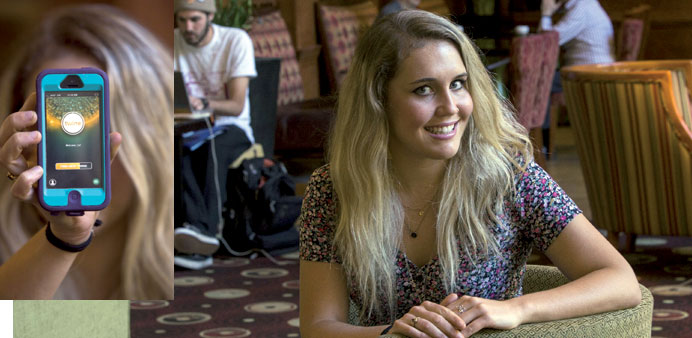By Dan Nakaso
Liz Azevedo, who’s 23 and single, has been using a new flirting/dating application called Twine to electronically connect with men here even though she does not know their names and has no idea what they look like.
Twine, which launched July 31, wants its users to form substantive connections based on common interests, instead of relying on appearances like most of the other dating apps on the market.
“At first I was a little turned off by it,” Azevedo said. “But after using the app, I like the fact that you’re actually getting to know people. With Twine you’re having real conversations and forming relationships before you even see them.”
In a digital dating world filled with an estimated 200 to 300 dating apps, San Francisco-based Twine stands out by initially hiding members’ identities and appearances, according to Mark Brooks, an Internet-dating industry analyst and consultant who has worked with Plentyoffish, DatingFactory, MeetMe, FriendFinder and Friendster.
Twine has members from San Francisco to Houston to Miami to New York and as far away as Singapore, Mumbai and London. It vows to keep an even ratio of men to women in each city, which solves a criticism of digital dating that women get “inundated by guys and guys are often ignored,” Brooks said. “Twine seems to have hit on two major elements: The privacy issue, which is very important for women concerned about safety, and the ignoring/inundation element.”
The dating app industry didn’t even exist before 2009, but today is exploding, according to two recent studies by IBISWorld.
While companies such as Twine closely guard the number of their members, some of the more popular apps today include Badoo, Tinder, OkCupid, Plentyoffish and Grindr, said Marc Lesnick, who organises the annual iDate conference of digital dating companies in Las Vegas, along with a couple of smaller iDate conferences around the world.
In 2011, for the first time, men and women spent more time on dating apps than on dating websites, according to IBISWorld. This year, the combination of growing niche markets — especially for aging baby boomers looking for dates — and increased interest in mobile dating apps is expected to generate “a robust” additional 4.1 percent in revenue for the online dating industry. This year apps are expected to represent up to 12 percent of the online dating industry’s $2 billion in revenue, according to IBISWorld.
IBISWorld projects growth of just under 5 percent each year through 2018 for dating apps. But the online dating industry considers them “a temporary stop-gap,” Lesnick said. “This app world we live in now is not going to be around forever.”
Users continue to complain about the limited features available on their smaller smartphone screens, along with advertisers who don’t like the size of their ads, Lesnick said.
Several of the most popular apps are also based on the “freemium” business model of allowing users free, limited use then charging them for “premium” features, such as the ability to send virtual flowers.
“The braggarts will tell you that they’re converting 10 percent of their users into paid customers,” Lesnick said. “They’re completely lying. There’s no way that 10 percent of the consumers on a free dating site actually pay for premium services. Most are seeing between 1 and 3 percent. Some might be seeing between 3 and 5 percent.”
San Francisco-based Sourcebits, an international technology development company, received $10 million from Sequoia and IDG to develop products that include Twine.
Twine is free to download for Android and iOS users and bucks the popular practice of hosting ads to generate revenue, and also foregoes membership fees charged by some other apps, according to its designers.
Etan Berkowitz, who co-founded Twine with CEO Rohit Singal, vowed that Twine “will always be advertising-free.”
Asked how he expects to make money from Twine, Berkowitz said, “As they say in the tech world, we’ll figure that out later. Perhaps we’d monetise, but it’s not on the table now.”
Azevedo describes herself as “super-outdoorsy” and connected with an avid rock climber. She also discovered a music connection with a man who, like Azevedo, attended San Francisco’s Outside Lands Music and Arts Festival.
“I like that they pair you with three people per day,” she said. “It’s more quality over quantity and it’s not overwhelming.”
But the most unusual aspect about Twine is the restriction it places on members’ ability to see one another, or even know each others’ names.
Through Twine, Azevedo was introduced virtually to one man, in particular, who has her attention. Someday, maybe soon, they might even decide to reveal each other’s identities and pictures, which has Azevedo worried.
“I think that will be interesting,” she said. “Obviously, appearance matters, so I’m nervous about seeing the person and not being attracted to them. At some point there does have to be a physical attraction. It’s exciting and scary at the same time.” — San Jose Mercury News/MCT
MOBILE DATING
From 2009 to 2012, revenue from mobile dating applications grew at an average annual rate of 70.3 percent.
The US market for mobile dating apps generates an estimated $212.6 million in revenue.
Between 2012 and 2017, revenue from mobile dating apps is expected to rise at an annual rate of 14.3 percent to $415.3 million.
In 2010, men and women spent 3.7 minutes on dating apps compared to 8.4 minutes on dating websites.
In 2011, they spent 8.4 minutes on dating apps compared to 8.3 minutes on dating websites.
Between 2010 and 2011, the number of unique users for all smartphone apps grew 125 percent. During the same period, the number of unique visitors for dating apps grew 150 percent.
Source: IBISWorld

